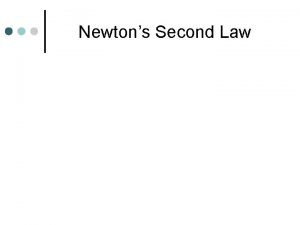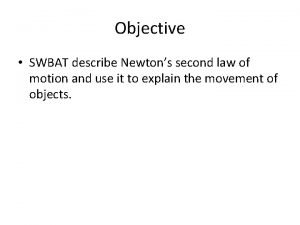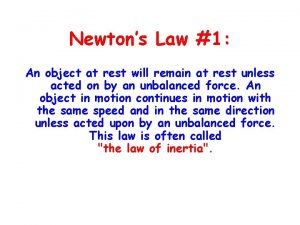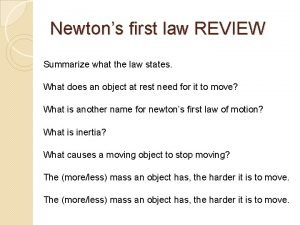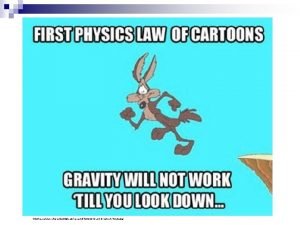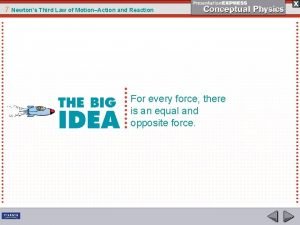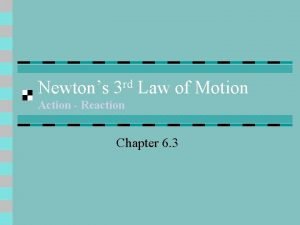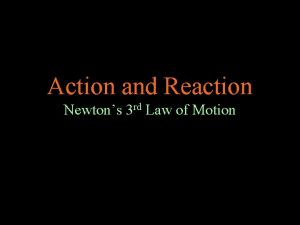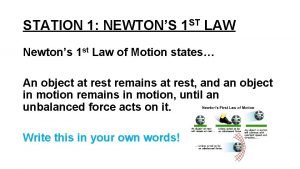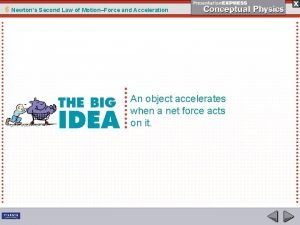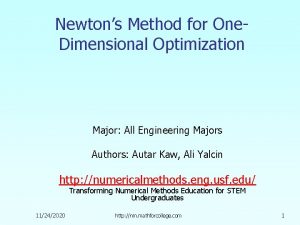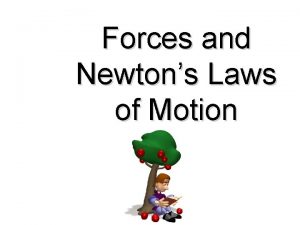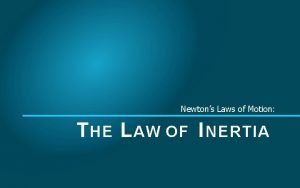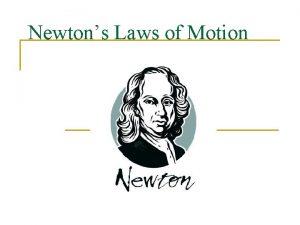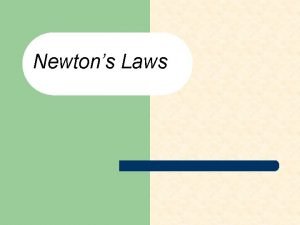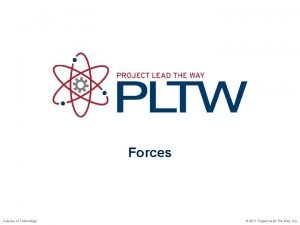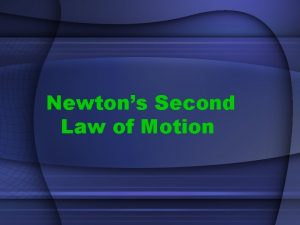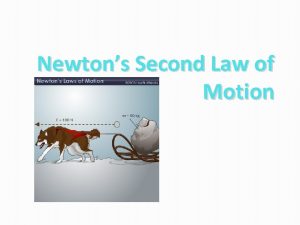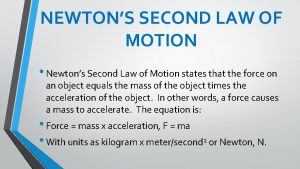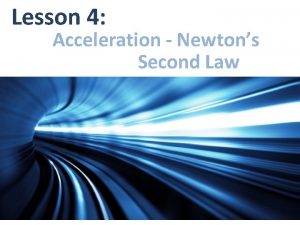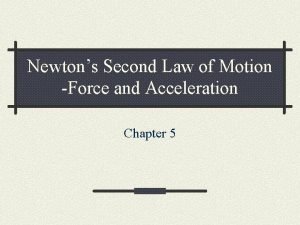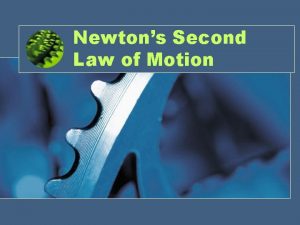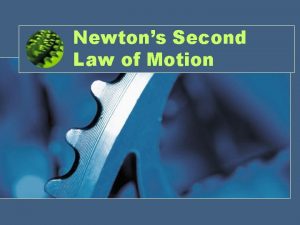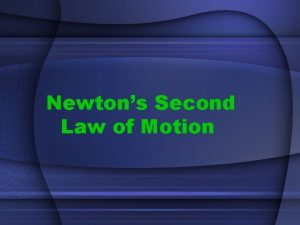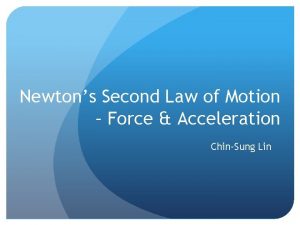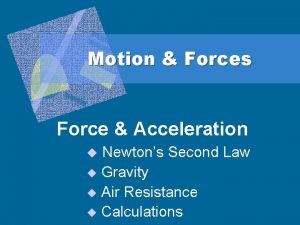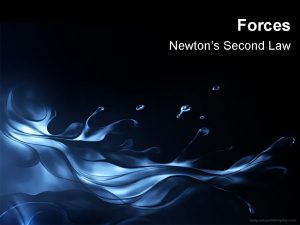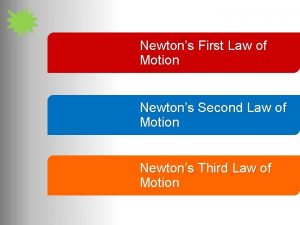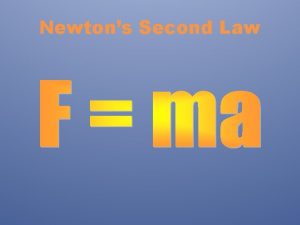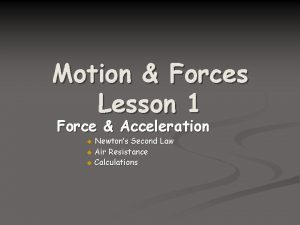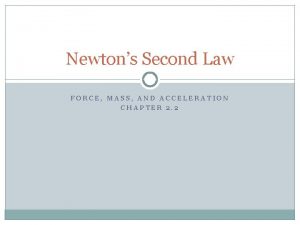Newtons Second Law of Motion Force and Acceleration


































- Slides: 34

Newton’s Second Law of Motion – Force and Acceleration Chapter 6

Objectives • State the relationship between acceleration and net force. • State the relationship between acceleration and mass. • State and explain Newton’s 2 nd law of motion. • List the factors that affect the force of friction between surfaces. • Distinguish between force and pressure. • Explain why the acceleration of an object in free fall does not depend upon the mass of the object. • List the factors that affect the air resistance force on an object.

6. 1 Force Causes Acceleration • At rest, a hockey puck is in equilibrium – gravity and the support force are balanced. • If a player exerts an unbalanced force on the puck (pushes it), it accelerates. • When the puck is no longer being pushed, there is no longer an unbalanced force acting on it. The puck does not accelerate but moves at constant velocity. * Unbalanced forces acting on an object cause the object to accelerate.

6. 1 Force Causes Acceleration • Since one force is usually not the only force acting on an object, we must amend our statement: Acceleration depends on net force. • In fact, an object’s acceleration is directly proportional to the net force acting on it. o If you double the force, the acceleration doubles. o If you increase the force by a factor of ten, the acceleration increases by a factor of ten. • We can write: acceleration ~ net force (The symbol ~ stands for “is directly proportional to”).

6. 2 Mass Resists Acceleration 100 N 0. 1 • Review the diagrams to the left. • The car of greater mass will accelerate less than the car of smaller mass with the same applied force. • Therefore, acceleration depends on the size of the mass being pushed. • In fact, acceleration is inversely proportional to the mass. • If mass is doubled (see diagram), then the acceleration is halved. • Acceleration ~ 1 mass • This means the 2 values change in opposite directions. If mass

6. 3 Newton’s Second Law • Newton realized acceleration depends not only on the force of a push but also on an object’s mass. * The acceleration produced by a net force on an object is directly proportional to the magnitude of the net force, is in the same direction as the net force, and is inversely proportional to the mass of the object.

6. 3 Newton’s Second Law • This means: acceleration ~ net force mass • When force is in newtons (N), mass is in kilograms (kg) and acceleration is in meters per second squared (m/s 2), we get the equation: acceleration = net force mass a = F/m or F = am

What is the acceleration due to gravity of these 2 objects? Recall: Force due to gravity = weight and W = mg

Practice • A car has a mass of 1250 kg. What is the acceleration produced by a force of 2250 N? • What is the acceleration if the force is doubled? • What is the acceleration if the mass is doubled? • How much force is needed to accelerate a 35, 000 kg plane by 1. 2 m/s 2? • If a car can accelerate at 5 m/s 2, what acceleration can it attain if it tows another

Practice • Suppose a plane is flying at a constant 900 km/hr and the thrust (force) of the engines is a constant 80, 000 N. What is the acceleration of the plane? • What is the force of air resistance that acts on the plane’s outside surface?

6. 4 Friction PUSH FRICTION • Recall (from Ch. 2 & 3) that friction acts on materials that are in contact with one another. • It always acts in a direction opposite to the relative motion. • Friction is due to irregularities in the 2 surfaces. It requires force for a surface to overcome the “bumps”

6. 4 Friction • More specifically, the force of friction depends on the KINDS of material that are in contact and HOW MUCH the surfaces are pressed together. ٠ For example, rubber against concrete produces more friction that steel against steel. • Friction occurs between solids, liquids, gases, or any combination of the states of matter.

Types of Friction Force • Static friction: the resistance force that must be overcome to start an object in motion. • Kinetic or sliding friction: the resistance force between two surfaces already in motion. • Rolling friction: the resistance force between a surface and a rolling object. • Fluid friction: the resistance force of a gas or a liquid as an object passes through. Air resistance is a special type of

Friction Force • Force of sliding friction = (coefficient of friction) (normal force) • Ff = µ x F n

6. 4 Friction • A diagram (like the ones shown here) in which all the forces acting on an object are shown is called a free-body diagram. • Here, the forces are balanced – the net force is zero in each case. Therefore, the objects are not accelerating but are moving with a constant velocity.

6. 5 Applying Force - Pressure • If you stand on your bathroom scale, the force measured is called your weight. (Fgrav = W = mg) • Will the reading change if you stand on one foot? • Will the reading change if you stand on one toe? • What does change?

6. 5 Applying Force - Pressure • Although the force (your weight) is the same in all 3 cases, the area of contact is different in each case. That is, the area supporting the weight in each case is different. • Since pressure is defined as force per unit area, Pressure = force or P = F area of application A it is the pressure exerted on the surface that changes in each of our cases • For a constant force, an INCREASE in area of contact will cause a DECREASE in the pressure.

Practice * Note: Pressure is measured in newtons (N) per square meter (m 2) or pascals (Pa). • What are 2 ways to increase the pressure on • something? What is the pressure exerted by a 400 N force if its contact area is • 4 m 2? • 0. 04 m 2?

6. 6 Free Fall Explained • Recall (Ch. 4) that in free fall, gravity is the only thing that affects a falling object. • Galileo showed that falling objects, regardless of their mass, accelerate equally. • Galileo could not explain why this was true.

6. 6 Free Fall Explained • Recall (Ch. 3) that mass and weight are proportional to each other. – A 10 kg. mass weighsabout 10 x as much as a 1 kg. mass. • In fact, since weight is the force of gravity on an object, we can use the equation F = ma to express weight this way: weight (W) = mass (m) times acceleration due to gravity (g) or W = mg.

6. 6 Free Fall Explained • Therefore, the ratio of weight (force) to mass is the same for any objects. • All free falling objects undergo the same acceleration at the same place on Earth. • This is represented by g

All freely falling objects fall with the same acceleration because the net force on an object is only its weight, and the ratio of weight to mass is the same for all objects. Cartoon from text p. 94

6. 7 Falling and Air Resistance In a vacuum (no air resistance) In presence of air

6. 7 Falling and Air Resistance • Focus on the feather in the 2 nd animation. • When falling in air, it is obvious that air resistance (a frictional force) does have an affect on the NET force of the falling objects – it decreases it. • The net force is equal to the force or weight of the object MINUS its air resistance. • Net Force = Fgrav - Fair • Therefore, since the Fnet is less, acceleration of a falling object is less and its resulting velocity is less.

Speed and Area • The two most common factors which have a direct effect upon the amount of air resistance present are: 1. The speed of the object: the greater the speed, the greater the force of air resistance. 2. The frontal area of the object: the greater the frontal area, the greater the air resistance.

Terminal Velocity • As a skydiver falls, his velocity continually increases – he is accelerating due to gravity. • Since air resistance is proportional to speed, as his speed increases so does the air resistance he encounters. • When the magnitude of the air resistance equals the weight of the skydiver (his force due to gravity), there is no longer any NET force on the sky diver

Terminal Velocity Fair Fgrav • With no net force on a falling object, there is no acceleration and the velocity remains constant. • The speed of an object when its acceleration is zero (because Fair balances Fgrav) is called the terminal speed. • Since we know the direction (downward), we can call it the terminal velocity.

• Objects which have a large area relative to their weight will reach their terminal velocity very quickly. ° The feather pictured above has a large area compared to its weight. It encounters a lot of air resistance very quickly. ° The elephant has a relatively small area compared to its weight. It will accelerate for a longer period of time before the force of air resistance equals the force due to gravity and the terminal velocity is reached.

Terminal Velocity • Since living things can change their body orientation, changing their “area” relative to their weight, they can somewhat control their terminal speed.

Terminal Velocity • Parachutes can also greatly increase air resistance. • Terminal velocity can be cut from 150200 km/hr. to 15 -25 km/hr. • Slow terminal speeds insure a safe landing.

A final note about Galileo. . • When Galileo dropped objects from the Leaning Tower of Pisa, the heavier object DID hit the ground first. The time difference was so small, however, it could not be detected. • At low speeds (short distances of fall), air resistance is negligible. • At high speeds (long falls where air resistance can “build up”), the effect of air resistance is more pronounced. • The effect of air resistance is also more pronounced on lighter objects. Lighter objects behave more like a parachute than heavier

Practice • What is the net force of the falling object? • What is the acceleration of the falling object? • What will be the acceleration of the object when it reaches its terminal velocity? • Which mass will reach the ground first – a 10 kg. mass or a 100 kg. mass? Fair = 10 N 10 kg. Fgrav = 100 N

Check your Understanding • A sky diver jumps from a hot air balloon. • As she falls faster & faster, does air resistance increase, decrease, or remain the same? • Does the net force on her increase, decrease, or remain the same? • As she falls faster & faster, does her acceleration increase, decrease, or remain the same? • How can she change the air resistance force she experiences?

Practice • Draw a series of free body diagrams to represent an 85 kg skydiver undergoing free fall. Show a diagram for the instances when the Fair is 0 N, 350 N, 700 N and 833 N. In each instance, determine the Fgrav, Fnet, and the acceleration.
 Application of newton's laws
Application of newton's laws Newton's second law of motion examples with diagram
Newton's second law of motion examples with diagram Newton's first law and second law and third law
Newton's first law and second law and third law Newton's first law and second law and third law
Newton's first law and second law and third law Newton's first law of motion in soccer
Newton's first law of motion in soccer Describe newtons second law
Describe newtons second law Newtons second law
Newtons second law Newtons second law example
Newtons second law example Newton's first law
Newton's first law Newtons 3 rd law of motion
Newtons 3 rd law of motion Newtons 3 rd law of motion
Newtons 3 rd law of motion Newton's third law
Newton's third law Newtons 3 rd law of motion
Newtons 3 rd law of motion Newton's second law meme
Newton's second law meme Newton's third law
Newton's third law Newton's third law
Newton's third law Newtons 3 rd law of motion
Newtons 3 rd law of motion Newton's 3 laws
Newton's 3 laws Newtons 3 rd law of motion
Newtons 3 rd law of motion 1st law of motion
1st law of motion Newtons law of motion
Newtons law of motion Laws of motion
Laws of motion Laws of acceleration
Laws of acceleration Relation between linear velocity and angular velocity
Relation between linear velocity and angular velocity Angular acceleration and linear acceleration
Angular acceleration and linear acceleration Centripetal acceleration tangential acceleration
Centripetal acceleration tangential acceleration Newtons second kaw
Newtons second kaw Newtons second kaw
Newtons second kaw Types of pendulum in physics
Types of pendulum in physics Newtons third lw
Newtons third lw Newton’s law of action-reaction
Newton’s law of action-reaction Newtons aw
Newtons aw Second law of motion
Second law of motion When the pellet fired into the spiral tube
When the pellet fired into the spiral tube Example for acceleration
Example for acceleration

